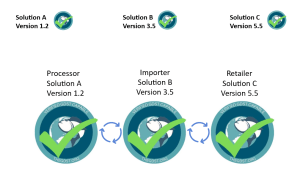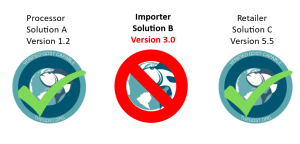In today’s increasingly digital global seafood industry, interoperability is essential for seamless data exchange and communication between different traceability systems. Achieving interoperability can significantly enhance efficiency, ensure compliance, and reduce errors in the supply chain. Here are three essential steps to achieve interoperability in seafood traceability:
- Standardization of Data
The first step towards interoperability is the standardization of data. This involves ensuring that the data collected and used by different systems is consistent and follows a common format. Standardization eliminates discrepancies and ensures that data can be easily interpreted and utilized across various platforms.
- Standardization of Data Formats
Once the data itself is standardized, the next step is to standardize the data formats. This means using common data structures and formats that can be universally understood by different systems. By adopting standardized data formats, organizations can ensure that data can be seamlessly exchanged and integrated without the need for custom conversions or manual interventions.
- Standardization of Communication Protocols
The final step in achieving interoperability is the standardization of communication protocols. This involves defining and adopting common protocols for data transmission and communication between systems. Standardized communication protocols ensure that data can be reliably transmitted across different platforms, enabling real-time data sharing and collaboration.
The Global Dialogue on Seafood Traceability (GDST) standard effectively achieves all three essential steps required for interoperability in seafood traceability. First, it ensures the alignment of data by defining Key Data Elements (KDEs) and Critical Tracking Events (CTEs) that must be captured and shared across the supply chain. Second, it standardizes data formats, which facilitates seamless data exchange between different systems. Finally, the GDST standard mandates the use of a standardized communication protocol to ensure reliable data transmission across platforms. By addressing these three critical aspects, the GDST standard supports robust and interoperable traceability systems for seafood products.

To ensure the GDST standards are implemented properly, therefore enabling interoperability, the GDST developed its’ Capability Test. This test is a software tool that simulates how two traceability systems share data during routine business transactions. It evaluates a solution’s ability to capture and share the required KDEs and master data in the format and communication method outlined in the GDST Standard. The Capability Test provides a simple YES or NO answer to whether a traceability solution can send and receive data based on the GDST standard. This helps industry partners focus on other aspects of traceability solutions when determining the right system for their needs. By passing the Capability Test, software solutions demonstrate their ability to communicate seamlessly with other systems that have also passed the test, ensuring efficient data exchange and reducing integration costs.
As a routine practice, the GDST recommends that solution providers use the Capability Test for each version of software they deploy to ensure it meets the GDST standard for interoperability. By consistently testing each version, providers can confirm that their solutions remain compliant with the GDST standard.
However, it is important for industry partners to remember that a passed test only applies to the version of the solution that took the test, and it is up to the solution provider to determine when they need to initiate a test again. Even though a solution may be listed on the GDST’s website, GDST knows some solution providers have multiple software versions of the same solution in use at any one time, therefore it is crucial to verify with your solution provider what version of their software you are using and whether it is a GDST Verified-Capable System. This is because if an untested version of the software is used, it may no longer meet the requirements of the GDST standard and could lack interoperability with other solutions that have passed the Capability Test. Ensuring that the version you are using is the one that has been tested by GDST helps maintain seamless data exchange and integration with other compliant systems, thereby avoiding potential issues and inefficiencies.
Take the following example:
Imagine there are three different solution providers, each offering a version of software that has passed the GDST Capability Test. Three supply chain partners choose different solutions, but because all versions have passed the Capability Test, they can exchange data seamlessly.

However, if one of the solution providers updates their system and deploys the update without retesting or has deployed a version older than the one that has passed the Capability test, there is no guarantee that they are interoperable.
Therefore, if the example is changed so that the Importer is using Solution Provider B’s version 3.0 (red), and not version 3.5 (green) that passed the test, it could result in an issue where data is not able to be properly received or shared with other supply chain partners.

GDST has annual unlimited capability testing packages available to software solution providers so that they can test all of the software that may be available and in use in seafood supply chains.
To achieve the digital interoperable seafood traceability commitments of you and your customers, please check what version of software you are using and ask your provider to ensure it has passed the capability test and is shown on the GDST website as GDST Verified-Capable.
———-
Relevant webpages
https://thegdst.org/resources/solutions/
https://thegdst.org/interoperability-the-key-to-unlocking-truly-traceable-seafood/
https://thegdst.org/resources/standard/
https://thegdst.org/wp-content/uploads/2024/07/GDSTS-OPEN-SOURCE-SOFTWARE-DEVELOPMENT-KITS-SDKS.pdf